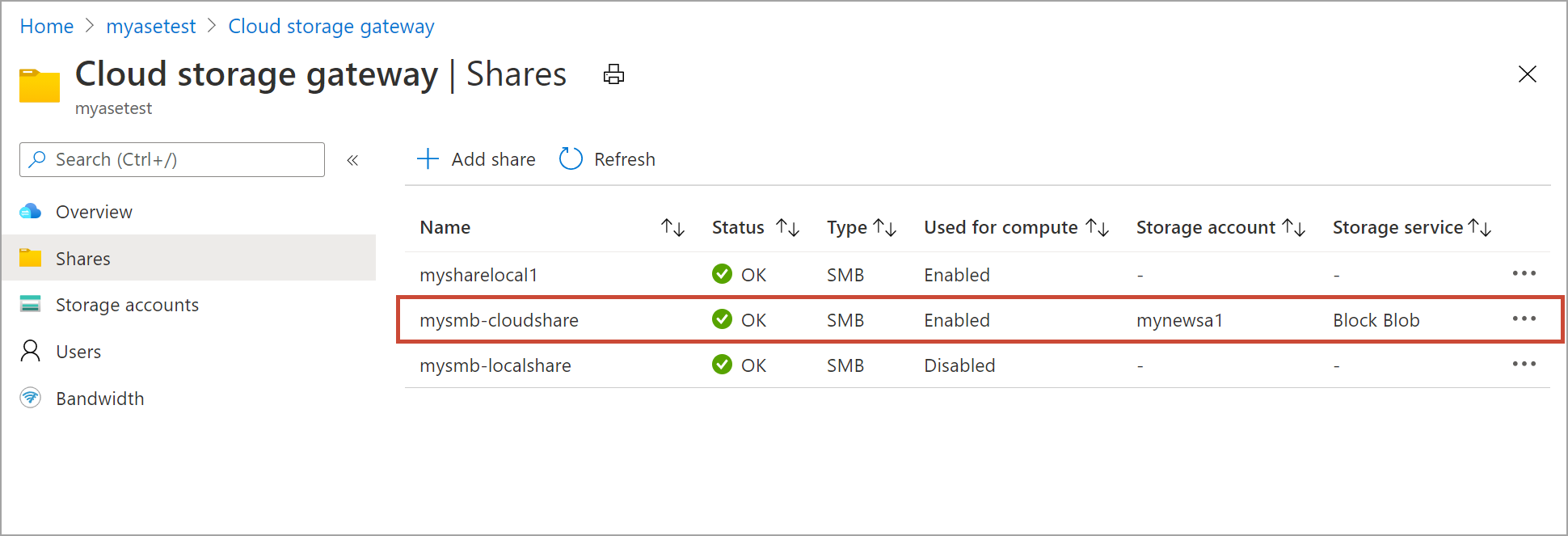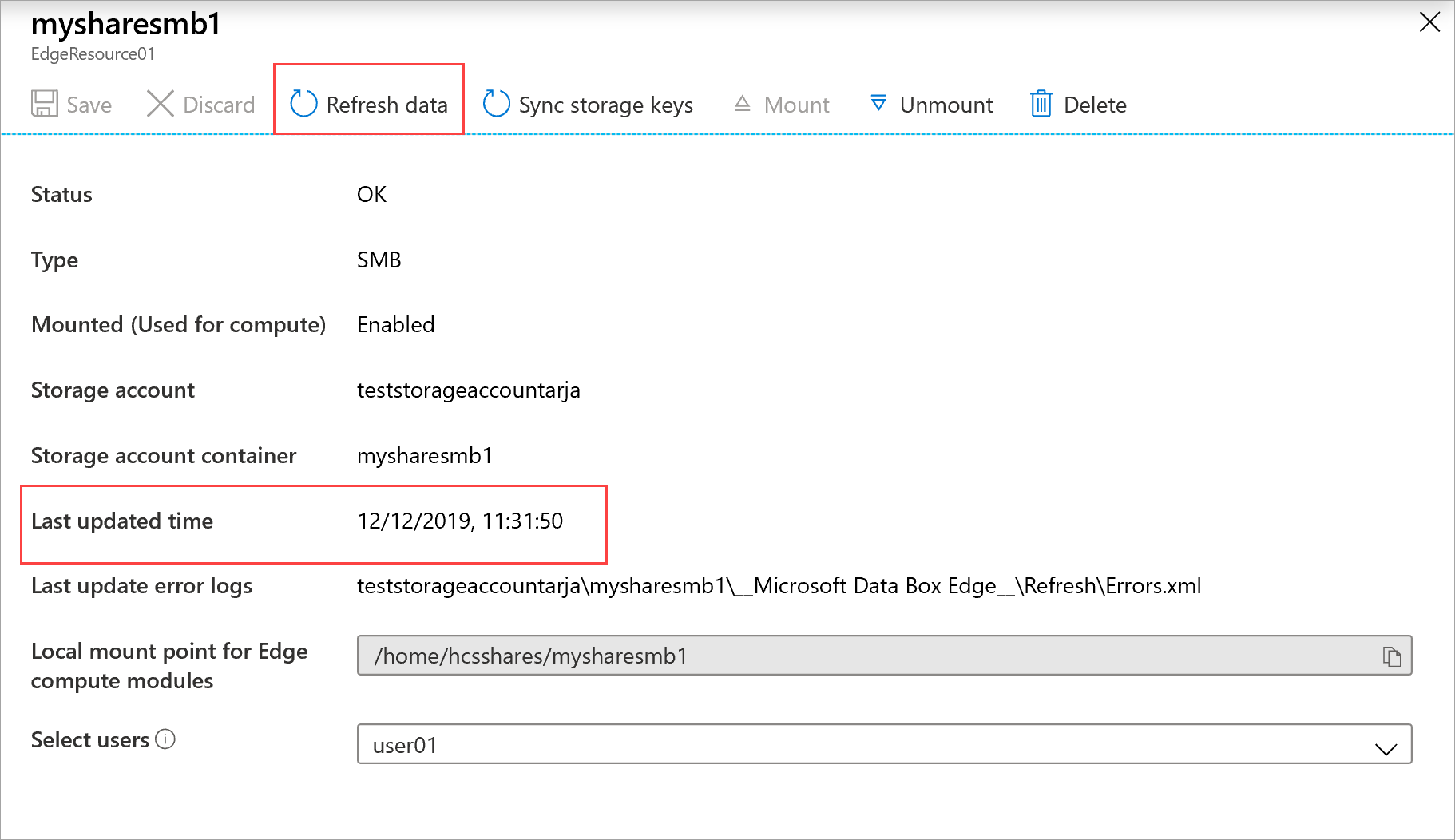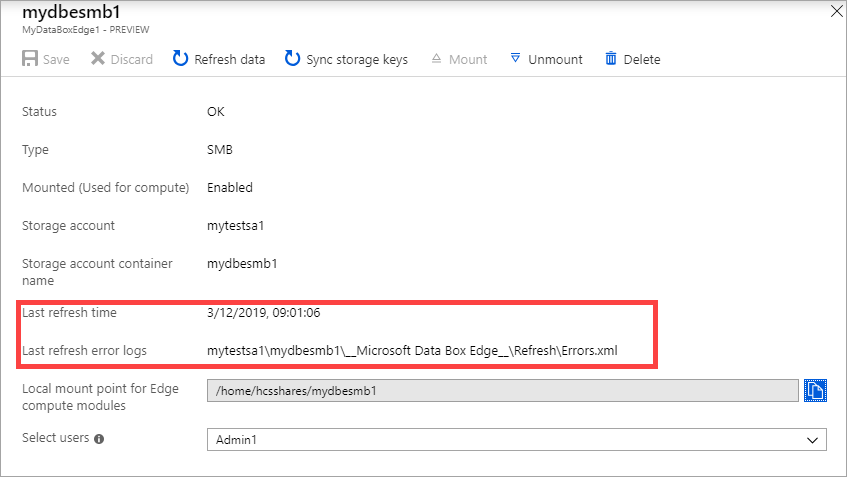Use Azure portal to manage shares on your Azure Stack Edge Pro
APPLIES TO:  Azure Stack Edge Pro - GPU
Azure Stack Edge Pro - GPU Azure Stack Edge Pro 2
Azure Stack Edge Pro 2 Azure Stack Edge Pro R
Azure Stack Edge Pro R Azure Stack Edge Mini R
Azure Stack Edge Mini R
This article describes how to manage shares on your Azure Stack Edge Pro. You can manage the Azure Stack Edge Pro via the Azure portal or via the local web UI. Use the Azure portal to add, delete, refresh shares, or sync storage key for storage account associated with the shares.
About shares
To transfer data to Azure, you need to create shares on your Azure Stack Edge Pro. The shares that you add on the Azure Stack Edge Pro device can be local shares or shares that push data to cloud.
- Local shares: Use these shares when you want the data to be processed locally on the device.
- Shares: Use these shares when you want the device data to be automatically pushed to your storage account in the cloud. All the cloud functions such as Refresh and Sync storage keys apply to the shares.
Add a share
Do the following steps in the Azure portal to create a share.
In the Azure portal, go to your Azure Stack Edge resource and then go to Cloud storage gateway > Shares. Select + Add share on the command bar.

In Add Share, specify the share settings. Provide a unique name for your share.
Share names can only contain numbers, lowercase letters, and hyphens. The share name must be between 3 and 63 characters long and begin with a letter or a number. Each hyphen must be preceded and followed by a non-hyphen character.
Select a Type for the share. The type can be SMB or NFS, with SMB being the default. SMB is the standard for Windows clients, and NFS is used for Linux clients. Depending upon whether you choose SMB or NFS shares, options presented are slightly different.
Provide a Storage account where the share lives. A container is created in the storage account with the share name if the container already doesn't exist. If the container already exists, then the existing container is used.
From the dropdown list, choose the Storage service from block blob, page blob, or files. The type of the service chosen depends on which format you want the data to reside in Azure. For example, in this instance, we want the data to reside as block blobs in Azure, hence we select Block Blob. If choosing Page Blob, you must ensure that your data is 512 bytes aligned. Use Page blob for VHDs or VHDX that are always 512 bytes aligned.
This step depends on whether you're creating an SMB or an NFS share.
If creating an SMB share - In the All privilege local user field, choose from Create new or Use existing. If creating a new local user, provide the username, password, and then confirm password. This assigns the permissions to the local user. After you have assigned the permissions here, you can then use File Explorer to modify these permissions.

If you check allow only read operations for this share data, you can specify read-only users.
If creating an NFS share - You need to supply the IP addresses of the allowed clients that can access the share.

To easily access the shares from Edge compute modules, use the local mount point. Select Use the share with Edge compute so that the share is automatically mounted after it's created. When this option is selected, the Edge module can also use the compute with the local mount point.
Select Create to create the share. You're notified that the share creation is in progress. After the share is created with the specified settings, the Shares blade updates to reflect the new share.
Add a local share
In the Azure portal, go to your Azure Stack Edge resource and then go to Cloud storage gateway > Shares. Select + Add share on the command bar.

In Add Share, specify the share settings. Provide a unique name for your share.
Share names can only contain numbers, lowercase and uppercase letters, and hyphens. The share name must be between 3 and 63 characters long and begin with a letter or a number. Each hyphen must be preceded and followed by a non-hyphen character.
Select a Type for the share. The type can be SMB or NFS, with SMB being the default. SMB is the standard for Windows clients, and NFS is used for Linux clients. Depending upon whether you choose SMB or NFS shares, options presented are slightly different.
Important
Make sure that the Azure Storage account that you use doesn't have immutability policies set on it if you're using it with an Azure Stack Edge Pro or Data Box Gateway device. For more information, see Set and manage immutability policies for blob storage.
To easily access the shares from Edge compute modules, use the local mount point. Select Use the share with Edge compute so that the Edge module can use the compute with the local mount point.
Select Configure as Edge local shares. The data in local shares will stay locally on the device. You can process this data locally.
In the All privilege local user field, choose from Create new or Use existing.
Select Create.

You see a notification that the share creation is in progress. After the share is created with the specified settings, the Shares blade updates to reflect the new share.

Select the share to view the local mountpoint for the Edge compute modules for this share.

Mount a share
If you created a share before you configured compute on your Azure Stack Edge Pro device, you'll need to mount the share. Take the following steps to mount a share.
In the Azure portal, go to your Azure Stack Edge resource and then go to Cloud storage gateway > Shares. From the list of the shares, select the share you want to mount. The Used for compute column will show the status as Disabled for the selected share.

Select Mount.

When prompted for confirmation, select Yes. This will mount the share.

After the share is mounted, go to the list of shares. You'll see that the Used for compute column shows the share status as Enabled.

Select the share again to view the local mountpoint for the share. Edge compute module uses this local mountpoint for the share.

Unmount a share
Do the following steps in the Azure portal to unmount a share.
In the Azure portal, go to your Azure Stack Edge resource and then go to Cloud storage gateway > Shares. From the list of the shares, select the share that you want to unmount. You want to make sure that the share you unmount isn't used by any modules. If the share is used by a module, then you'll see issues with the corresponding module.

Select Unmount.

When prompted for confirmation, select Yes. This will unmount the share.

After the share is unmounted, go to the list of shares. You'll see that Used for compute column shows the share status as Disabled.

Delete a share
Use the following steps in the Azure portal to delete a share.
From the list of shares, select and click the share that you want to delete.

Select Delete.

When prompted for confirmation, select Yes.

The list of shares updates to reflect the deletion.
Refresh shares
The refresh feature allows you to refresh the contents of a share. When you refresh a share, a search is initiated to find all the Azure objects including blobs and files that were added to the cloud since the last refresh. These additional files are then downloaded to refresh the contents of the share on the device.
Important
- You can't refresh local shares.
- Permissions and access control lists (ACLs) aren't preserved across a refresh operation.
Do the following steps in the Azure portal to refresh a share.
In the Azure portal, go to Shares. Select and click the share that you want to refresh.

Select Refresh.

When prompted for confirmation, select Yes. A job starts to refresh the contents of the on-premises share.

While the refresh is in progress, the refresh option is grayed out in the context menu. Select the job notification to view the refresh job status.
The time to refresh depends on the number of files in the Azure container and the files on the device. Once the refresh has successfully completed, the share timestamp is updated. Even if the refresh has partial failures, the operation is considered successful and the timestamp is updated. The refresh error logs are also updated.

If there's a failure, an alert is raised. The alert details the cause and the recommendation to fix the issue. The alert also links to a file that has the complete summary of the failures including the files that failed to update or delete.
Sync pinned files
To automatically sync up pinned files, do the following steps in the Azure portal:
Select an existing Azure storage account.
Go to Containers and select + Container to create a container. Name this container as newcontainer. Set the Public access level to Container.

Select the container name and set the following metadata:
- Name = "Pinned"
- Value = "True"

Create a new share on your device. Map it to the pinned container by choosing the existing container option. Mark the share as read only. Create a new user and specify the user name and a corresponding password for this share.

From the Azure portal, browse to the container that you created. Upload the file that you want to be pinned into the new container, that has the metadata set to pinned.
Select Refresh data in Azure portal for the device to download the pinning policy for that particular Azure Storage container.

Access the new share that was created on the device. The file that was uploaded to the storage account is now downloaded to the local share.
Anytime the device is disconnected or reconnected, it triggers refresh. Refresh will bring down only those files that have changed.
Sync storage keys
If your storage account keys have been rotated, then you need to sync the storage access keys. The sync helps the device get the latest keys for your storage account.
Do the following steps in the Azure portal to sync your storage access key.
Go to Overview in your resource. From the list of shares, select a share associated with the storage account that you need to sync.

Select Sync storage key. Select Yes when prompted for confirmation.

Exit out of the dialog once the sync is complete.
Note
You only have to do this once for a given storage account. You don't need to repeat this action for all the shares associated with the same storage account.
Next steps
- Learn how to Manage users via Azure portal.
Feedback
Coming soon: Throughout 2024 we will be phasing out GitHub Issues as the feedback mechanism for content and replacing it with a new feedback system. For more information see: https://aka.ms/ContentUserFeedback.
Submit and view feedback for